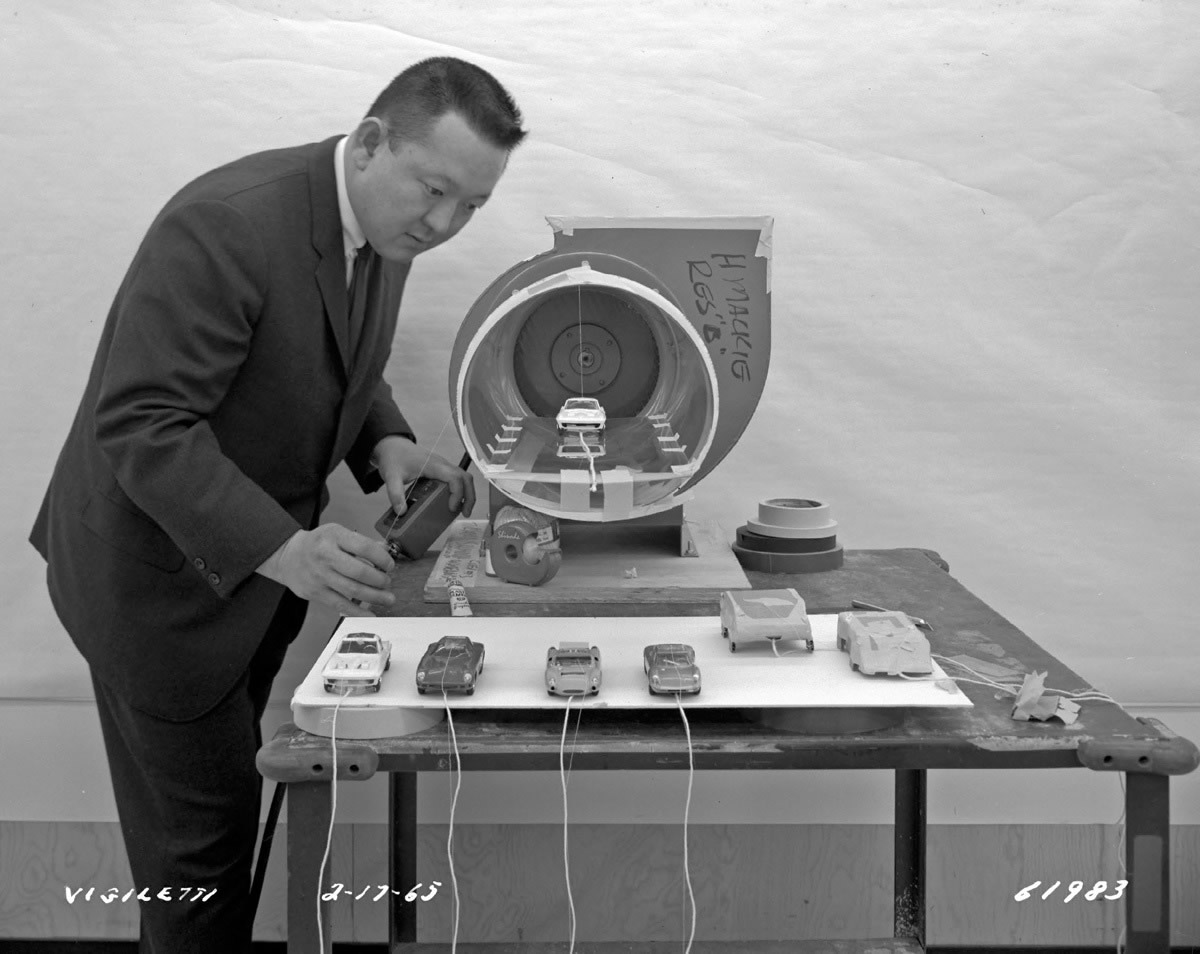Larry Shinoda Interview on the History of Corvette - Page 2 of 2
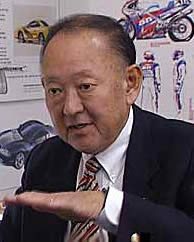 Profile: Larry Shinoda
Profile: Larry Shinoda
Interview with Larry Shinoda
© Wayne Ellwood, 1995
Used here with permission by the author
Post GM Years
When Semon "Bunkie" Knudsen left GM in 1968, he recruited me to follow along. I had met him originally when I was working on the Zink Special at INDY. He had asked me some questions about aerodynamics and apparently liked my answers. We became good friends. When he asked me to return to Ford with him I thought it would be a good challenge. It took a little bit longer than expected to get me in, but he did create the new job of Director, Special Projects Design Office for me. I was in charge of all high performance production and limited production vehicles.
The primary project I was recruited to work on at Ford had been a possible two-seater sports car to compete with Corvette. We were also competing internally with the deTomaso (Italian) firm for final design and production. This is a pretty standard approach to designing new cars; there are always internal competitions to force the various groups to do their very best. Then management gets the final word on which design goes ahead. In this case, my design (called the Mach 2C) lost and the deTomaso design won. I did a lot of different projects.
I also worked on the design themes for the Boss 302 and the 1971 Pinto. But my work with the Torino Talladega and the Mercury Cyclone Spoiler I and II cars were really good mixes of design for aerodynamic efficiency with performance. My Torino Talladega was approximately 15 MPH faster than a production version. If it takes about 20 HP to gain each additional MPH at the high end (around 18OMPH), then the design was worth about 300 HP. To me, that was a success.
Apparently, there were a few others at Ford who didn't quite share my enthusiasm, however. Mr. Knudsen decided to move to White Motors about 16 months later and, politics being what they are, I went with him.
Current Projects
In 1976, following his departure from White Motor Corporation, Larry started his own company, Shinoda Design Associates Inc. From there it has been a matter of following his heart, dedicating his energies to projects which intrigue him and, not coincidentally, permit him to continue new Corvette concepts from time to time. The Rick Mears Corvette project has been one of Larry's most successful "post-GM" Corvette projects and it will be covered in an upcoming issue. Larry picks up his review of current history.
Q. WHAT OTHER CURRENT PROJECTS ARE YOU WORKING ON? ARE YOU STILL DOING A LOT FOR FORD?
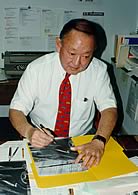 A. Well not really. We're trying to do work for Ford but this BOSS Mustang car model idea seems to have them a little upset. The kit, by Revell-Monogram is starting to sell well. Juef is also building a kit based on the Coletti car, the 429, 604 c.i. version. It will be yellow and will say "Boss" on it.
A. Well not really. We're trying to do work for Ford but this BOSS Mustang car model idea seems to have them a little upset. The kit, by Revell-Monogram is starting to sell well. Juef is also building a kit based on the Coletti car, the 429, 604 c.i. version. It will be yellow and will say "Boss" on it.
I am also doing some motorhomes for Monaco Coach, in Elkhart, Indiana. These are the large vehicles based on their own chassis which they build in-house. They are about the size of a Greyhound bus. They cover quite a range of sizes but the signature series is the one I am currently working on. They have just introduced two smaller series called Executive and Dynasty. They are also working on a new unit called the Windsor.
Q. SINCE 1989 WHAT ARE SOME OF THE PROJECTS YOU WORKED ON, ESPECIALLY THE WORK WITH NIPPON PAINT? YOU SEEM TO HAVE BEEN INVOLVED IN A LOT OF IMPORTANT PROJECTS.
A. Well, one of the most interesting ones is something called "Gashopper". It's really a two-seater moped with weather protection.
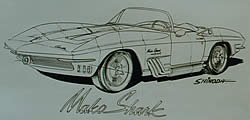 The Nippon Paint deal is to be a "net-worker" for them. I can use my contacts to help introduce their product to people that they don't normally have access. I know a lot of the top people in the companies whereas they, as paint suppliers, tend to be limited to the purchasers. Mazda used their paint 100%, but Toyota only sourced about 10% from Nippon Paint, mostly primers not top coats. I set up some events which eventually helped them meet the right people in order to present their ideas. In this way, they improve their market share. Same with Honda and Mitsubishi. In fact, another company called Daihatsu is located right in their hometown but didn't use them. Historically they used Kansai Paint like a lot of the other Toyota companies. We still haven't made big progress there but...
The Nippon Paint deal is to be a "net-worker" for them. I can use my contacts to help introduce their product to people that they don't normally have access. I know a lot of the top people in the companies whereas they, as paint suppliers, tend to be limited to the purchasers. Mazda used their paint 100%, but Toyota only sourced about 10% from Nippon Paint, mostly primers not top coats. I set up some events which eventually helped them meet the right people in order to present their ideas. In this way, they improve their market share. Same with Honda and Mitsubishi. In fact, another company called Daihatsu is located right in their hometown but didn't use them. Historically they used Kansai Paint like a lot of the other Toyota companies. We still haven't made big progress there but...
I also participate in their color shows and do a little presentation. The last one in 1990 had "vitality" as a theme so I took some examples from the Geneva and Detroit Auto Shows and put together a little slide presentation that lasts about 8 minutes.
Q. I AM ALSO INTRIGUED BY THE WORK YOU DID ON GRAPHICS AND UNIFORMS FOR EARNHART AND OTHERS.
A. Yes, I actually did most of the work for the Dale Earnhart cars. Also the Corvette GTP color scheme as it was becoming successful with Rick Hendricks. Now it is interesting to hear why the GTP program was canned just as it was coming around. Ryan Falconer did most of the engine work but Herb Fischel doesn't really appreciate Ryan as much as some other people do. So, there may have been a lot of corporate reasons but it didn't help that Falconner wasn't politically correct. But when they wrote him out of the deal the whole program sort of went down. At least, that seems to me to be the most significant factor.
LARRY KIYOSHI SHINODA
March 25, 1930 - November 13, 1997
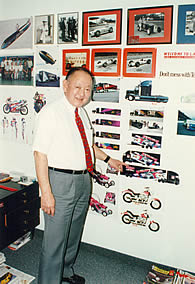 Designer gave world the Corvette Stingray
Designer gave world the Corvette Stingray
November 15, 1997
BY SUZANNE SIEGEL
Free Press Staff Writer
As a boy in California during World War II, Larry Shinoda was held in an internment camp for Japanese Americans. As a young man, he built hot rods and drag-raced them on the streets of Los Angeles. And as an adult, he designed the 1963 Corvette Stingray, widely considered one of the most beautiful and quintessentially American cars to roll off Detroit's assembly lines.
Mr. Shinoda of Novi died of heart failure Thursday at Botsford General Hospital in Farmington Hills. He was 67.
"He always loved cars -- fast cars," his wife of 39 years, Joyce, said Friday.
"He was a wonderful designer and a wonderful husband," she said.
Mr. Shinoda designed for General Motors Corp., Ford Motor Co. and later went into business for himself. His cars had major impact on the industry.
David Smith, editor of Ward's Auto World, Shinoda's friend for 30 years, called the Stingray a "breakthrough."
"He built high-performance engines in cars that had the look to go with it," Smith said. "He was the father of the hot-rod-on-wheels approach."
Mr. Shinoda's career in design started with doodling. He drew cars even as a grade-schooler, his wife said.
After he and his family were interned at the Manzanar relocation camp in California's Owens Valley, he later served two years in the Air National Guard and Air Force, including 16 months in Korea.
In the 1950s, Mr. Shinoda was drag racing when he wasn't attending art school. He worked briefly as a commercial artist for Douglas Aircraft before the Ford Motor Co. lured him to Detroit in January 1955. He soon left Ford for GM, where he worked from 1956 to 1968.
After GM, he returned to Dearborn briefly, following his mentor and friend Semon (Bunkie) Knudsen. At Ford in 1968-69, he was responsible for the Boss 302 and Boss 429 editions of the 1970 Mustang.
Shortly after Knudsen was axed by Ford, Mr. Shinoda, too, was let go. Mr. Shinoda was fiery, Smith said.
"He was pretty controversial. He was not loved by everyone. He didn't have a small ego and if he didn't like a design, he'd say it stinks."
Most recently, Mr. Shinoda was president of Shinoda Design Associates in Livonia. His work ranged from race cars to motor homes to jackets.
In addition to his wife, Joyce, he is survived by daughters Karen Shinoda Flahive and Lisa, and son Keith.
Visitation at McCabe Funeral Home at 31950 W. Twelve Mile in Farmington Hills is scheduled for Sunday. Call 1-248-553-0120 anytime for the times. The funeral will be at 2 p.m. Monday at the funeral home.
